CMOS Optical Preamplifier Design Using Graphical Circuit Analysis
CMOS Optical Preamplifier Design Using Graphical Circuit Analysis
CMOS Optical Preamplifier Design Using Graphical Circuit Analysis
You also want an ePaper? Increase the reach of your titles
YUMPU automatically turns print PDFs into web optimized ePapers that Google loves.
4.2 <strong>Circuit</strong> <strong>Analysis</strong> <strong>Using</strong> Driving-Point Impedances 79<br />
The representation of a node voltage as a Z DP × I SC product can be used to<br />
analyze entire circuits. As a first attempt, the procedure can be expressed in the fol-<br />
lowing steps:<br />
1. Attach auxiliary voltage sources, vn , to each node of the linear circuit network.<br />
2. Determine the driving-point impedance and short-circuit current of each<br />
node.<br />
3. Finally, the circuit equations are represented by the DPI relations for each<br />
node,<br />
vn = Z DPn × I SCn<br />
(4.3)<br />
and by the relations that dictate the values of all sources, both dependent and<br />
independent.<br />
Ultimately, the concept of placing auxiliary voltage sources is not essential. The<br />
idea is simply a convenient paradigm for guiding our analysis and allowing us to<br />
apply our traditional understanding of superposition.<br />
EXAMPLE 4.1 A SIMPLE LINEAR CIRCUIT<br />
We can demonstrate DPI analysis with a simple example. Consider the circuit in<br />
Figure 4.3, and determine the node voltages given that = 1Ω , Rb = 5Ω , and<br />
I dc<br />
= 1A .<br />
I x =<br />
2V b<br />
V 1<br />
Begin by placing auxiliary voltage sources at nodes 1 and 2. When current source<br />
I dc is zeroed, nodes 1 and 2 are isolated. As such, the driving-point impedances are<br />
R a<br />
R a<br />
I<br />
1 dc<br />
2<br />
Figure 4.3 Simple circuit example to demonstrate DPI analysis.<br />
V b<br />
+<br />
-<br />
R b<br />
V 2














